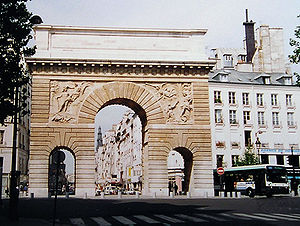
Porte Saint-Martin
Encyclopedia

Paris
Paris is the capital and largest city in France, situated on the river Seine, in northern France, at the heart of the Île-de-France region...
ian monument located at the site of one of the gates of the now-destroyed fortifications of Paris. It is located at the crossing of Rue Saint-Martin, Rue du Faubourg Saint-Martin and the grands boulevards Boulevard Saint-Martin and Boulevard Saint-Denis.
History
The Porte Saint-Martin was designed by architectArchitect
An architect is a person trained in the planning, design and oversight of the construction of buildings. To practice architecture means to offer or render services in connection with the design and construction of a building, or group of buildings and the space within the site surrounding the...
Pierre Bullet (a student of François Blondel
François Blondel
Nicolas-François Blondel was a soldier, engineer of fortifications, diplomat, civil engineer and military architect, called "the Great Blondel", to distinguish him in a dynasty of French architects. He is remembered for his Cours d'architecture which remained a central text for over a century...
, architect of the nearby Porte Saint-Denis
Porte Saint-Denis
The Porte Saint-Denis is a Parisian monument located in the 10th arrondissement, at the site of one of the gates of the Wall of Charles V, one of the now-destroyed fortifications of Paris...
) at the order of Louis XIV in honor of his victories on the Rhine and in Franche-Comté
Franche-Comté
Franche-Comté the former "Free County" of Burgundy, as distinct from the neighbouring Duchy, is an administrative region and a traditional province of eastern France...
. Built in 1674, it replaced a medieval gate in the city walls built by Charles V
Charles V of France
Charles V , called the Wise, was King of France from 1364 to his death in 1380 and a member of the House of Valois...
. It was restored in 1988.
Description
The Porte Saint-Martin is a heavily rusticatedRustication (architecture)
thumb|upright|Two different styles of rustication in the [[Palazzo Medici-Riccardi]] in [[Florence]].In classical architecture rustication is an architectural feature that contrasts in texture with the smoothly finished, squared block masonry surfaces called ashlar...
triumphal arch
Triumphal arch
A triumphal arch is a monumental structure in the shape of an archway with one or more arched passageways, often designed to span a road. In its simplest form a triumphal arch consists of two massive piers connected by an arch, crowned with a flat entablature or attic on which a statue might be...
, 18 meters high, built in limestone
Limestone
Limestone is a sedimentary rock composed largely of the minerals calcite and aragonite, which are different crystal forms of calcium carbonate . Many limestones are composed from skeletal fragments of marine organisms such as coral or foraminifera....
and marble
Marble
Marble is a metamorphic rock composed of recrystallized carbonate minerals, most commonly calcite or dolomite.Geologists use the term "marble" to refer to metamorphosed limestone; however stonemasons use the term more broadly to encompass unmetamorphosed limestone.Marble is commonly used for...
. Recesses are occupied by bas reliefs:
- North side left: La Prise du Limbourg en 1675 (The Capture of LimbourgLimbourgLimbourg is a medieval town located in the province of Liège, Wallonia, Belgium.On 1 January 2008 Limbourg had a total population of 5,680. The total area is 24.63 km² which gives a population density of 231 inhabitants per km²...
) by Pierre Legros I, a sitting woman next to a lion - North side right: La Défaite des Allemands (The Defeat of the Germans) by Gaspard Marsy, Louis XIV as MarsMars (mythology)Mars was the Roman god of war and also an agricultural guardian, a combination characteristic of early Rome. He was second in importance only to Jupiter, and he was the most prominent of the military gods worshipped by the Roman legions...
carrying the shield of France and pushing back a German eagle to protect a woman and an old man - South side left: La Rupture de la Triple Alliance (The Breaking of the Triple Alliance) by Étienne le Hongre, Louis XIV as HerculesHerculesHercules is the Roman name for Greek demigod Heracles, son of Zeus , and the mortal Alcmene...
, partly nude - South side right: La prise de BesançonBesançonBesançon , is the capital and principal city of the Franche-Comté region in eastern France. It had a population of about 237,000 inhabitants in the metropolitan area in 2008...
(The Capture of Besançon) by Martin van den Bogaert, Louis XIV dressed as Fame, standing in front of an olive tree and receiving keys from a womean

